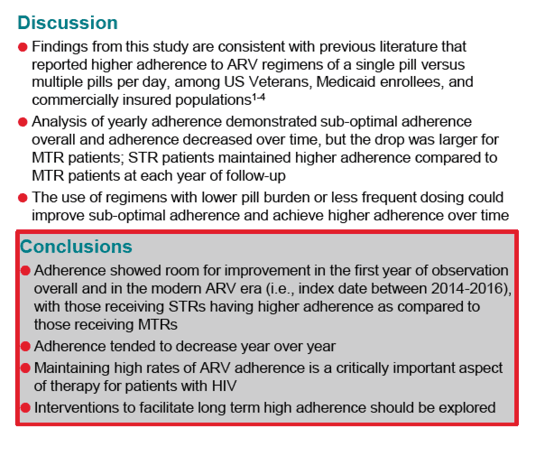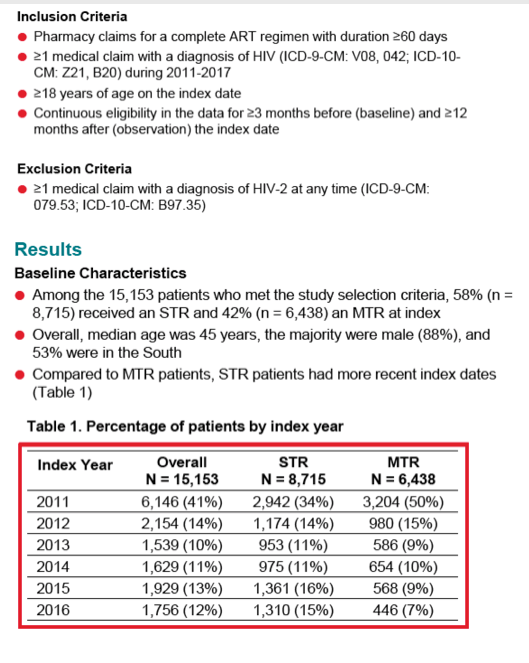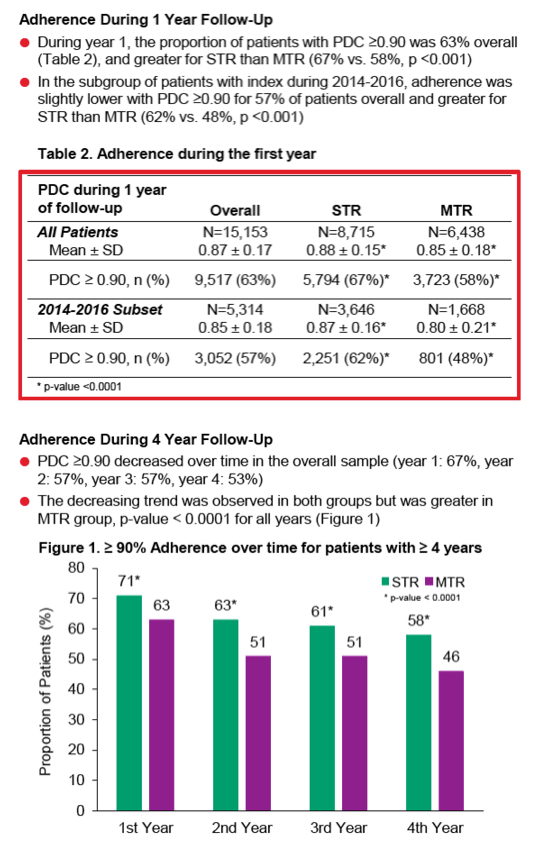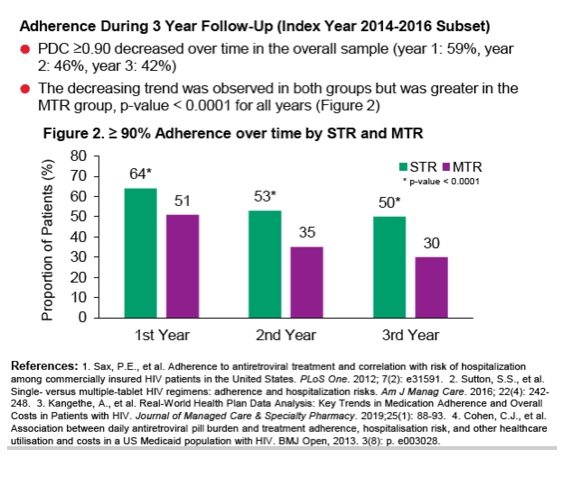 |
 |
 |
| |
ART Adherence Falls Over 4 Years in 15,000 Insured People in US
|
| |
| |
IDWeek, October 2-6, 2019, Washington, DC
Mark Mascolini
Adherence to antiretroviral therapy (ART) dropped steadily over 4 years of treatment in 15,000 US residents with private health insurance [1]. This sobering decline persisted when researchers limited the analysis to more recent years, when simpler, more tolerable regimens gained wider use.
Research tends to show better adherence and HIV suppression with single-tablet regimens (STRs) than multitablet (MTR) regimens. But adherence to contemporary regimens over several years remains poorly understood. To address this question, researchers from ViiV Healthcare and Analysis Group in Boston conducted this study.
This retrospective analysis involved antiretroviral-treated people in the Optum Clinformatics US-based commercial insurance database from January 2011 to December 2017. The investigators calculated adherence as proportion of days covered (PDC), defined as the number of nonoverlapping days in the study period covered by a complete STR or MTR regimen divided by the number of days in a fixed period of 1 year.
The primary analysis involved adherence over 1 year from the date when an STR or MTR regimen began, then yearly analysis among people with 4 or more years of follow-up. A secondary analysis focused on people treated in 2014-2016 to assess the impact of more recent regimens. People eligible for these analyses had to be at least 18 years old when treatment began; they required continuous enrollment for at least 3 months before that start date and at least 12 months after that start date.
The study included 15,153 people, 8715 (58%) taking an STR and 6438 (42%) taking an MTR. Most participants, 88%, were men, 53% lived in the South, and median age stood at 45 years.
During the first year of ART, the overall proportion of people with PDC-measured adherence at or above 90% was 63%. That rate was significantly higher in people taking an STR than an MTR (67% versus 58%, P < 0.001). In the subgroup starting ART in 2014-2016, adherence in the first year was lower than the overall rate, with 57% at or above a PDC adherence rate of 90%. Again the rate was better with STRs than MTRs (62% versus 48%, P < 0.001).
Proportions of participants with at least 90% adherence fell steadily through 4 years of ART, from 67% in year 1, to 57% in year 2, 57% in year 3, and 53% in year 4. In each year, at least 90% adherence always proved significantly better with an STR than an MTR (71% versus 63% in year 1, 63% versus 51% in year 2, 61% versus 51% in year 3, and 58% versus 46% in year 4, P < 0.0001 for all).
Among people who began ART in 2014-2016, at least 90% PDC adherence in the first 3 years of treatment proved worse than in the overall group and dropped with each year--59% in year 1, 46% in year 2, and 42% in year 3. The adherence rate was always better with an STR than an MTR (64% versus 51% in year 1, 53% versus 35% in year 2, and 50% versus 30% in year 3, P< 0.0001 for all).
The study confirms consistently better adherence with an STR than an MTR in this large, privately insured US HIV population. But when measured as proportion of days covered, as in this study, overall adherence was lackluster and dropped relentlessly from year to year with both STRs and MTRs. The researchers proposed that adherence to current regimens "showed room for improvement," but many will see that as an understatement.
Reference
1. Priest J, Bhak R, DerSarkissian M, et al. Decreasing adherence to antiretroviral therapy over 4 years of follow-up in a commercially-insured population of patients with HIV. IDWeek, October 2-6, 2019, Washington, DC. Abstract 2512

Decreasing Adherence to Antiretroviral Therapy over 4 years of Follow-up in a Commercially-Insured Population of Patients with HIV
Julie Priest, MSPH1, Rachel Bhak, MS2, Maral DerSarkissian, PhD2, Cindy Garris, MS1, Alan Oglesby, MPH1, Colin Kunzweiler, PhD2, Ellie Fuqua, BA2, Suna Park, MS2, Mei Sheng Duh, MPH, ScD2
1ViiV Healthcare, Durham, NC, USA; 2Analysis Group, Inc., Boston, MA, USA


.


.
|
| |
|
 |
 |
|
|